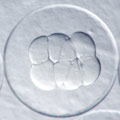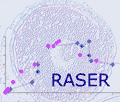Progress through the project rests on achieving three objectives, namely:
 Cod egg with 8 cells Cod egg with 8 cells
- Develop methodology to reduce costs of assessment and increase the precision in estimating realised fecundity (number of eggs spawned)
- Assessment of cod and Northern hake reproductive potential across their latitudinal range
- Synopsis work packages
· Evaluate the impact on assessment and management of including models of more realistic variations in population reproductive potential for cod and hake.
· Assess the geographic variation in size and age at maturity, fecundity and spawning activity in relation to the observed variation in environmental conditions including fishing pressure.
· Incorporate new experimentally proven data on atretic and post-ovulatory follicle duration into previous ICES Egg Production Based (EPB) assessments to determine the potential bias in the assessment of realised fecundity and spawning stock biomass (SSB).
To develop more cost-effective tools automation through modern image analysis, i.e., less reliance on costly histology, will be used frequently in the laboratory for fecundity estimation, and accurate assessment of the dynamics of spawning and atretic follicle degradation undertaken by conducting a series of laboratory experiments for less uncertainty in EPB assessment. Following from this, new information will be provided on reproductive potential of cod and hake (considered to be data poor species in this respect according to ICES Recruitment Workshop 2001 and 2002) across their latitudinal range (cod: North Sea - Barents Sea; hake: northwest Spain - western Norway). These data will be used to quantify the benefits of including such processes in current stock assessment procedures and developing alternative management strategies where appropriate. An evaluation on the potential costs and benefits of incorporating fisheries independent methods (egg production over a daily period or annual basis) into assessment of spawning stock biomass will also be produced. |

